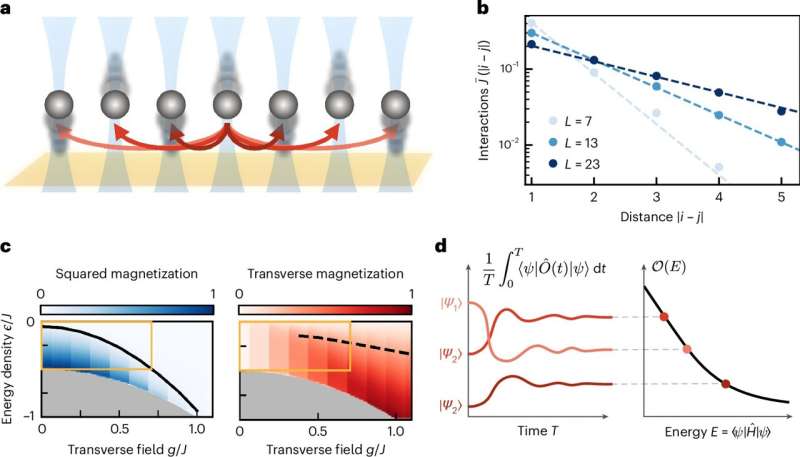February 6, 2025 feature
This article has been reviewed according to Science X's editorial process and policies. Editors have highlighted the following attributes while ensuring the content's credibility:
fact-checked
peer-reviewed publication
trusted source
proofread
Researchers observe a phase transition in a 1D chain of atoms using a quantum simulator

Phase transitions, shifts between different states of matter, are widely explored physical phenomena. So far, these transitions have primarily been studied in three-dimensional (3D) and two-dimensional (2D) systems, yet theories suggest that they could also occur in some one-dimensional (1D) systems.
Researchers at the Duke Quantum Center and the University of Maryland recently reported the first observation of a finite-energy phase transition in a 1D chain of atoms simulated on a quantum device. Their paper, published in Nature Physics, introduces a promising approach to realizing finite-energy states in quantum simulation platforms, which opens new possibilities for the study of phase transitions in 1D systems.
The recent study is a collaborative effort that combined the work of theoretical physicists at the University of Maryland with that of experimental physicists at the Duke Quantum Center, where the quantum simulator was placed and where the experiments were carried out.
"Our research was driven by a desire to understand the fundamental states that matter can exist in," Alexander Schuckert, the lead theoretical author of the paper, told Phys.org. "Specifically, we aimed to explore a phase change in a one-dimensional (1D) chain of atoms—a phenomenon that had been predicted theoretically but remained unobserved experimentally."
Conventional physical theories suggest that phase transitions, such as the freezing of water into ice or a magnet going from a magnetized to a demagnetized state, do not occur in 1D systems. However, some physicists recently suggested that, under some specific conditions, phase transitions could take place in a single dimension.
"Theories by physics heroes Dyson and Thouless (Nobel prize winners) proposed that if the atoms interact over long distances, these transitions could happen," said Schuckert. "Our primary objective was to create a controlled environment using a quantum simulator to observe this elusive phase change."
Using a device known as a trapped-ion quantum simulator, the researchers were able to simulate a system comprised of 23 ytterbium ions (i.e., charged atoms) arranged into a 1D chain. This device was built in a multi-year effort led by Christopher Monroe at the Duke Quantum Center. Monroe supervised the research together with professors Gorshkov and Hafezi at the University of Maryland.
"By carefully controlling the interactions between these ions using electromagnetic fields, we effectively built a 1D magnet, atom by atom using this quantum simulator," explained Or Katz, the lead experimental author of the paper. "A big challenge in quantum simulators is to effectively heat the system, to observe a phase transition as a function of temperature (or equivalently, energy) because this requires coupling to a heat bath.
"For example, when heating water in a kettle, we couple the water to a heated metal plate. However, this is challenging in quantum simulators because any coupling to a bath would disrupt the quantum state."

To overcome the challenges associated with the heating of systems in quantum simulators, Schuckert devised a new experimental technique. This technique was then successfully implemented by Katz and Monroe as part of the experiments performed at the Duke Quantum Center.
Essentially, this technique consists of preparing ions in a specific initial condition and then allowing them to evolve following their own natural dynamics. This natural evolution mimicked the effects that would take place following an increase in temperature.
"Using this method, we observed the system transition from a magnetized (ordered) state to an unmagnetized (disordered) state, confirming the occurrence of the phase change," said Katz. "Our most significant achievement was the first experimental observation of a phase transition in a 1D chain of atoms, a phenomenon which had never been observed in a physical system.
"This was made possible by the ability of our experiment at Duke to engineer long-range interactions between the ions and effectively preparing them in a heated state."
The results of this recent study highlight the potential of quantum simulators as tools for exploring exotic states of matter. In the future, the experimental methods devised by Katz, Monroe, Schuckert and their colleagues help to better understand complex quantum materials, which could in turn inform the development of new quantum technologies.
"One possible avenue for future investigations will be to expand this research by arranging ions into two-dimensional arrays, which would allow the study of more complex systems and potentially discover new phases of matter," added Schuckert.
"We also aim to extend our heated-state preparation method to more complex models of materials, particularly to study low (but finite) temperatures, as our current methods are limited to fairly high temperatures. Achieving this would enable us to model a broader range of physical phenomena and deepen our understanding of quantum behaviors in various materials."
More information: Alexander Schuckert et al, Observation of a finite-energy phase transition in a one-dimensional quantum simulator, Nature Physics (2025). DOI: 10.1038/s41567-024-02751-2. On arXiv: DOI: 10.48550/arxiv.2310.19869
Journal information: Nature Physics , arXiv
© 2025 Science X Network





















